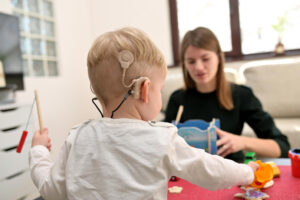
Managing behaviour in a classroom setting can be challenging. However, when it comes to students with Special Educational Needs (SEN), teachers and teaching assistants must adopt especially thoughtful and adaptable strategies. These students often require a more individualised approach to ensure that they can participate fully in learning and social activities.
If you’re working with special needs children and are stuck on how to go about managing the behaviours of your students, we’ve got you covered! We will identify classroom-based strategies, which may be useful in meeting pupils’ needs within their lessons. By implementing the following techniques, SEN teachers and teaching assistants can create an environment where all students feel valued and able to achieve their potential.

Positive Reinforcement
One of the most effective strategies in behaviour management is positive reinforcement. SEN students often respond well to rewards for positive behaviour rather than punishments for negative actions. This could be verbal praise, stickers, or earning time for a preferred activity. The key is to make the reinforcement immediate and specific, so the student knows exactly what behaviour is being rewarded.
Clear and Consistent Rules
Clear, simple, and consistent rules are crucial for SEN students, who may not understand complicated instructions. Visual aids such as charts or pictures can help reinforce what is expected of them. Consistency in enforcing these rules, across different times and settings, helps students learn appropriate behaviours more quickly.
Structured Environment
A structured classroom environment can significantly reduce undesirable behaviours. This includes having a predictable routine, organised physical spaces, and clearly defined areas for different activities. Such structure helps SEN students feel secure and understand what is expected of them throughout the school day.
Choice Offering
Giving students choices can be a powerful technique to manage behaviour. By allowing choices in their activities, how they complete tasks, or with whom they work, teachers can motivate students and reduce behavioural issues. Choices empower students and give them a sense of control, which can lead to better engagement and reduced frustration.
Use of Visual and Verbal Cues
Visual and verbal cues can help guide behaviour before issues arise. Visual schedules, timers, and cues can help students understand transitions and prepare for changes in activities, which can often be triggers for behavioural issues. Gentle verbal reminders can also help reorient a student’s attention and reinforce expectations.
Collaborative Goal Setting
Work with pupils to find out what they need. Engaging students in discussions about their own needs and goals can be useful. This collaborative approach not only respects their input but can lead to more personalised and effective strategies. Ask them what helps them feel calm, focused, and happy at school, and integrate this feedback into your behaviour management approach.
Breaks and Sensory Tools
Scheduled breaks can be particularly beneficial for students who may become overwhelmed or overstimulated. During these breaks, sensory tools like stress balls, resistance bands on chair legs, or quiet areas can help students manage sensory overload and regain focus.
Adapt the Physical Environment
Modifying the classroom layout to minimise distractions can significantly benefit SEN students. Consider factors like seating arrangements away from high-traffic areas, using partitions for students who benefit from reduced visual stimulation, or creating clearly marked zones that help students understand where different activities take place.
Clear Communication
Communicate clearly and simply. Use clear, concise language when giving instructions or setting expectations. Rephrasing complex directions into simpler terms and using visual aids or gestures can help ensure that all students, regardless of their abilities, understand what is expected of them. Consistent language and symbols used across various contexts help reinforce learning and understanding.
Individual Behaviour Plans
For students with more significant challenges, individual behaviour plans (IBPs) tailored to meet their specific needs can be effective. These plans are developed in collaboration with SENCOs, psychologists, and parents to ensure that the strategies are cohesive and supported across home and school environments.
Structured Reward Systems
Set up reward systems for good behaviour. Develop structured reward systems that are predictable and easily understood. This can involve a token economy where students earn tokens for specific behaviours and exchange them for a reward, or a chart where progress towards a reward is visually tracked. Ensure that the rewards are meaningful to the students and aligned with their interests or needs. This method not only motivates but also teaches valuable skills related to cause and effect, planning, and delayed gratification.

Behaviour management for SEN students isn’t about enforcing a rigid set of rules but rather about creating a supportive learning environment that anticipates and meets their unique needs.
By implementing these strategies, educators can help SEN students navigate their school day successfully. Ultimately, the goal is to equip these students with the skills to manage their behaviour, enhancing their ability to learn and interact with others both inside and outside of the classroom. This approach not only benefits the students but also contributes to a more inclusive and supportive educational environment for everyone involved.
Are you interested in starting your career in SEN education? Click the link below to view our latest SEN job vacancies.




























